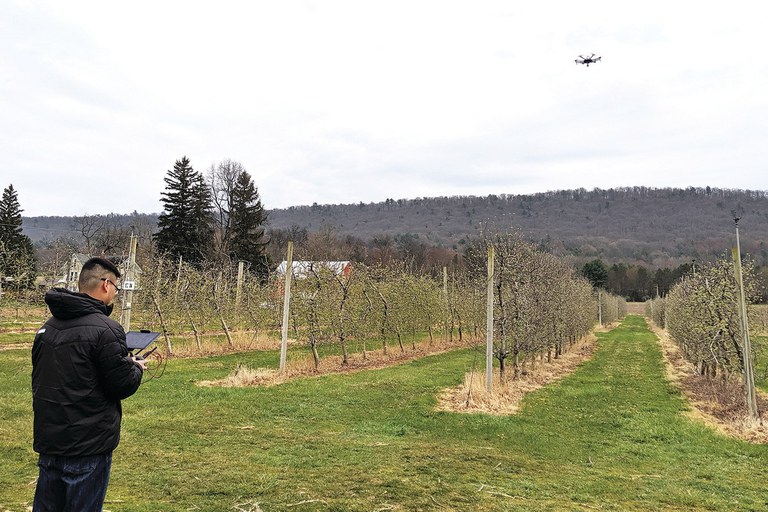Posted: December 2, 2022
A novel lighting system helps agricultural robots "see" clearly.

A researcher flies a drone over an apple orchard at Penn State's Russell E. Larson Agricultural Research Center. The drone was used to shoot a video of the demonstration of the over-current driven LED lights machine vision mechanism. Credit: Penn State
A novel camera system using active lighting devised by Penn State researchers may be a crucial step in developing machine vision systems that allow robotic devices to more clearly "see" the agricultural targets with which they will interact.
The system--using "over-current driven" LED lights to produce a powerful flash capable of firing multiple times a second--creates reliable daytime imaging, according to team leader Daeun Choi, former assistant professor of agricultural and biological engineering. The approach overcomes variable lighting and color inconsistencies due to sunlight, she explained, and largely eliminates motion blur that occurs due to vehicle movement and vibrations from ground terrain.
"In the future, this system or one like it will likely be used to guide mechanisms that independently perform labor-intensive tasks such as pruning apple trees, estimating fruit yield, fruit thinning, and mushroom picking," Choi said. "The innovative aspect of this research was that the current drawn by the LED lights was increased by a factor of six times its normal rating, resulting in increased illuminance."
The research was conducted, Choi added, because more farmers are interested in adopting technologies in precision agriculture and automation to increase output and efficiency. Driven by an increase in global competition, rising food demand from population growth, and consumers' expectations of higher quality agricultural products, producers are turning to machine vision systems with remote sensing devices for collecting and analyzing data in agricultural applications.
Research team member Omeed Mirbod, a doctoral student in agricultural and biological engineering, designed a circuit for storing and releasing energy to the leds to produce a strobe-like effect and a controller used for synchronizing the strobe with a camera to acquire images.
"Artificial intelligence does well with images that are really rich with information, so the important thing is capturing high-quality images," he said. "For agriculture, we need images that are invariant to outdoor lighting conditions. If you capture an image in which a fruit is very saturated with light due to the sun, and then capture another one in shadow where there is little sunlight, the artificial intelligence that you're training to detect the fruit might struggle to identify it."
In findings published in Computers and Electronics in Agriculture, the researchers reported that images captured by the prototype system were of very high quality. Additionally, the prototype system was able to fix motion blur in machine vision images with the camera moving at about four miles per hour.
--Jeff Mulhollem
Features
Fostering Forests
Across the United States, forests face unprecedented threats, and scientists in Penn State's College of Agricultural Sciences are conducting novel and complex research to conserve them.
Buzzing With Purpose
Community scientists work to protect Pennsylvania's wild bees
Conservation Reimagined
Exploring new approaches to cope with a changing climate


